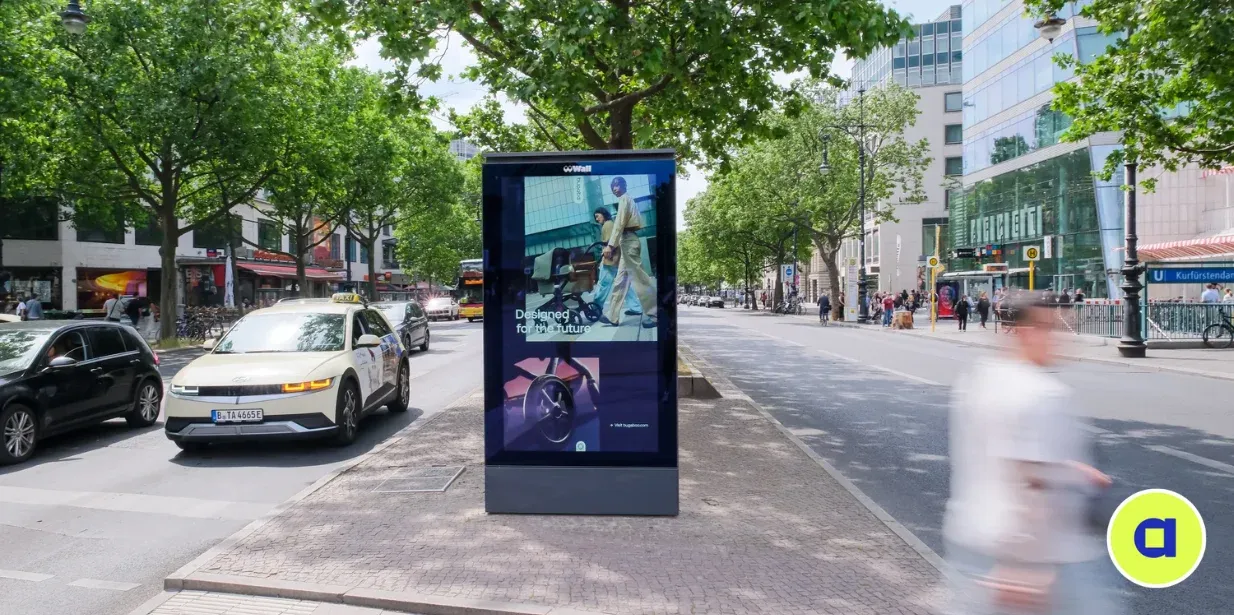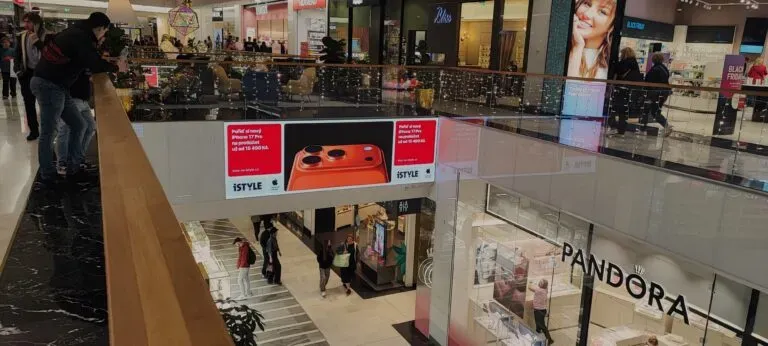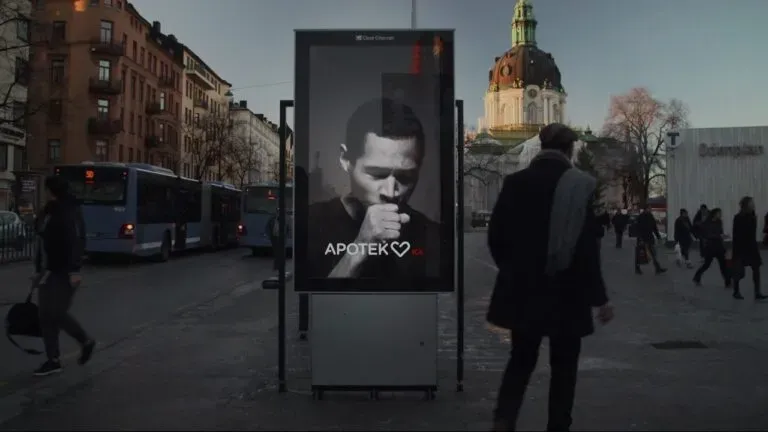Psychology of perception in outdoor advertising: 3 seconds to succeed
Outdoor advertising in cities has long moved beyond just printed billboards.
Today, digital formats are actively developing — from DOOH (Digital Out Of Home) with large LED screens on bustling streets to interactive video walls in shopping centers and business parks. Such solutions allow brands to adapt their messages to the time of day, weather conditions, or even pedestrian density.
For example, an ad campaign may display business offers for office workers in the morning and entertainment content for restaurant visitors in the evening. For this, modern video wall software plays a key role, synchronizing content between screens, and intelligent digital signage players ensure uninterrupted broadcasting and rapid creative updates. This technological set enables businesses not only to attract the attention of passersby, but also to create a sense that the advertising “lives” in the rhythm of the city.
Why the first seconds are decisive
The streets of modern cities are saturated with informational stimuli: cars, shop windows, people, ads. The brain filters this stream and focuses attention only if something seems interesting or useful to it. This is exactly why DOOH formats embed the principle of maximum simplicity and instant delivery of meaning.
From the psychological perspective, these few seconds are crucial. Research shows the human brain scans the environment in the first second and weeds out “noise” — objects that don’t matter. Only those messages that elicit immediate interest or emotion have a chance of sticking in short-term memory and being “stored” for decision-making about a brand or product.
Additional facts:
– For digital screens, it’s important that content doesn’t change too often, so viewers have time to grasp the information.
– Experience with city LED video walls shows that moving images with high contrast grab attention better than static banners.
– Even if contact with the ad isn’t enough for full comprehension, repeated encounters with the same campaign raise brand recognition.
Principles that work in DOOH and Programmatic DOOH
To make advertising “work at speed,” creatives should be built according to proven rules:
– Concise text: 3–5 words in the headline; phrases should be simple and understandable even for those quickly moving through the city.
– Large visual elements: Objects should be clear even from a distance of 20–30 meters. Well-built design allows you to formulate the message without overloading it.
– Contrasting colors: Bright shades attract the eye, especially in day–night conditions or variable lighting.
– Focus on emotions: Images that appeal to the experience of local residents, familiar situations, or current trends (for example, holidays, sporting events).
Additional ideas:
– It is always important to test different design variations — A/B testing helps find combinations that are most memorable.
– Using animations and gentle dynamics enhances ad memorability, especially with brief contact.
– In Programmatic DOOH, it is important to consider timing — for example, during rush hour, it is better to show ads that address the urgent needs of the audience.
The role of technology in precise ad targeting
Technological infrastructure is key in modern campaigns. pDOOH enables not only planning ad displays but also flexibly updating content according to the context.
Integration of various platforms — software for video walls, digital signage players — drives automation in advertising campaigns. These solutions allow you to:
– Set different display scenarios for various city zones — for example, show youth promotions near universities and family offers in residential areas.
– Use sensor data: weather conditions, time of day, number of people in a certain area — all these can influence ad content.
– Optimize budgets — thanks to statistics on views and reactions, displays can be allocated most effectively.
– Collect data for further analysis: video wall software helps obtain information about view frequency, the best-performing times, and audience interaction features.
Additional facts about technology:
– A modern digital signage player often supports integration with Wi-Fi analytics or mobile services, allowing you to launch geolocation campaigns for the most relevant audience.
– Innovative pDOOH solutions allow you to leverage artificial intelligence to analyze viewer behavior and select content “on the fly”.
How pedestrians and drivers perceive outdoor advertising
The faster a person moves, the less time they spend on external objects. This rule is especially relevant for Digital Out Of Home (DOOH) formats, which compete for attention amid city noise.
A pedestrian, on average, looks at a screen or banner for up to 3 seconds. If the advertisement is located at a public transport stop, near a crosswalk, or in places where people pause, they have a chance to notice details: read the slogan, remember the brand, or spot contact information.
A driver perceives images even faster — within 1–1.5 seconds. This is particularly true for video ads and dynamic banners along the roadside. Only in slow traffic or jams can interaction times with content stretch from a few seconds to a minute. But even then, effective advertising should be readable instantly.
Where location works for you
Most effective DOOH units are set up in spots where:
– there is a regular flow of people or vehicles,
– traffic slows or stops (traffic lights, intersections, congestion),
– the visibility of the unit isn’t blocked by other objects.
Here, it’s especially important to follow the principle of minimalism: short text, clear visual accents, and a strong offer.
Placement can be enhanced with technology:
– With DOOH DSPs, you can target content for the right time of day and audience.
– DOOH SSPs help manage displays across different screens based on inventory availability.
Peripheral vision and its role in advertising perception
The human eye can process part of visual information even without a direct gaze — this is the effect of peripheral vision. Bright, contrasting, or moving objects “catch” attention almost subconsciously.
Outdoor ad designers take into account:
– contrast colors and large fonts,
– the presence of faces or emotional elements,
– conciseness and recognizable shapes.
For digital signage, this effect is especially important. DOOH software allows selection of visuals and animations that enhance peripheral perception, and digital signage players ensure these elements are delivered correctly at the right moment.
How the brain selects information in the urban environment
Every day, residents of big cities receive hundreds of visual and auditory signals. To avoid overload, the brain sets up “filters” — it selects only what directly relates to a person’s needs.
Research confirms that we primarily react to:
1. familiar logos and brands;
2. short, emotional messages;
3. images that correspond to needs: food, children, safety, money, etc.
That is why video advertising in DOOH format, integrated via DSP and SSP platforms, can work effectively “on autopilot” — it falls into familiar patterns of perception and does not require effort from the viewer to decode the content.
How to create a creative that hits instantly
Modern DOOH networks operate in environments where the attention of passersby and drivers disperses very quickly. For street advertising to work, the creative must evoke an emotional response literally at first glance. This could be surprise, a smile, or a moment of recognition.
Familiar symbols and visual metaphors help convey meaning even before a person focuses on all the details. For example, a stop sign, a key, an upward arrow, or a heart icon are instantly associated with specific concepts. On LED billboards, such elements appear bright and clear even from afar.
Emotions, humor, and associations
Our brain remembers emotions better than dry information. That is why humor works effectively in street advertising—it lowers the critical perception and creates a sense of closeness between the brand and the viewer.
Associations based on familiar images help reduce the time to perceive the message. This is especially important in cases where ad screens are located along roads or in busy pedestrian areas, where contact lasts mere seconds.
How to test creative for street advertising
Professional teams recommend using the “three-second test” for any layouts intended for digital street screens.
It’s worth checking:
– Whether it’s clear in a short time who you are and what you offer.
– Whether there is an emotional reaction — a smile or surprise.
– Whether the image is clearly visible from a great distance while moving.
To prepare for placement, creative can be tested on a smartphone: show the image to a person at arm’s length for three seconds, then ask: what was memorable, which brand and meaning. If even one point is hard to recall, the design needs improvement.
How technology enhances the effect in DOOH
Modern video advertising in urban spaces is a combination of powerful content and technology. DOOH Display Solutions make it possible to control image dynamics, brightness, and colors to convey an idea as expressively as possible.
Animation draws attention thanks to movement, which stands out amid the static urban environment. Short loops lasting 5–10 seconds help avoid overload while emphasizing the logo, offer, or key idea.
Software for LED screens
The effective operation of modern billboards and screens is based on professional LED screen software. It allows you to:
– plan displays at multiple locations simultaneously;
– adjust brightness and color saturation depending on the time of day or weather;
– work with remote management and fast content replacement.
Such tools are especially valuable for large DOOH networks covering dozens or hundreds of advertising points in a city.
Capabilities of modern advertising screens
Large LED billboards and other outdoor display formats are becoming a platform for personalized advertising narratives. Today, advertisers can adapt content to local events, weather changes, or even pedestrian flow in real time.
Creatives displayed on such mediums blend into the urban environment while standing out through bright colors, contrast, and dynamic elements. In this way, DOOH networks transform the advertising space into a living media channel.
Contextual targeting in DOOH advertising
One of the main advantages of modern DOOH advertising is the ability to instantly adapt messages to external conditions. This makes city digital screens not just a tool for broadcasting static images, but a living medium that responds to the reality around it.
Just a few years ago, a billboard was the same for everyone who passed or drove by. Now, digital screens can display entirely different stories depending on the weather, time of day, location, or even events happening in the city. Thanks to digital technologies and tools like Supply-Side Platform, screen owners can instantly change content and automatically manage displays.
How contextual adaptation works
1. Weather conditions
During rain, the screen can broadcast an offer to buy an umbrella or a hot drink, and on a sunny day — cold ice cream or lemonade. Such content changes create a sense that the advertisement “knows” what is happening around and offers exactly what is relevant.
2. Time of day
In the morning, people think about coffee, a snack, and a quick breakfast, so a coffee shop ad appears on the screen. In the evening — offers from pizzerias, cinemas, or dinner delivery services.
3. Geolocation
If a screen is located near a shopping center, it can display advertising discounts in a specific store or a message like “turn right in 100 m.”
4. Events and news
During major sports matches, greetings or special offers for fans can be broadcast. On holidays — greetings for residents of a specific district.
All this is made possible by centralized video management systems that allow quick uploading, changing, and synchronizing content across dozens of screens simultaneously.
Why viewers perceive this as “live” advertising
When a person sees a message that directly corresponds to their current conditions — “hot mulled wine in the rain” or “20% discount at the store nearby” — it is perceived personally. This increases attention to the ad and raises the chances that the viewer will take action: enter the store, use a QR code, or remember the brand. Such personalization is a key difference of modern networks, where DOOH advertising combines creativity and real-time data.
Examples of possibilities
In large cities, there are already street screens that synchronize content with city events. For example:
– During a major marathon, advertising of sportswear and drinks can be broadcast along the route.
– Near train stations and airports — offers from taxis or hotels when information about an arriving flight appears.
– In tourist areas — posters of local exhibitions and festivals.
This flexibility is possible only if media owners use a Supply-Side Platform to manage digital inventory, and advertisers integrate creatives through automated platforms.
The importance of conciseness in context
Even when advertising is as relevant as possible, it must follow the main rule of street communications — time for perception is limited. A person spends no more than 2–3 seconds on the content. That is why the design should be simple, the message — clear, and the visual — emotional and recognizable. One bright key visual is better than several small details that will be missed.
Advision — Content Management System for remote management, media planning of video and audio content broadcasting and Supply-Side Platform for monetization of advertising time. We help Digital Signage owners and DOOH advertising operators earn on advertising placement, automate workflows and build a reliable media infrastructure using our own software solutions.
Contact us if you want to increase your profit and implement the most modern technologies to solve problems!
Share the news




















